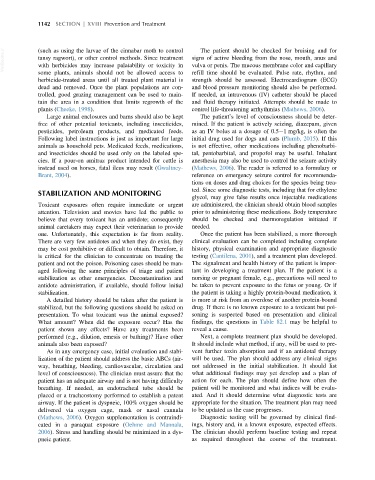Page 1211 - Veterinary Toxicology, Basic and Clinical Principles, 3rd Edition
P. 1211
1142 SECTION | XVIII Prevention and Treatment
VetBooks.ir (such as using the larvae of the cinnabar moth to control signs of active bleeding from the nose, mouth, anus and
The patient should be checked for bruising and for
tansy ragwort), or other control methods. Since treatment
vulva or penis. The mucous membrane color and capillary
with herbicides may increase palatability or toxicity in
some plants, animals should not be allowed access to refill time should be evaluated. Pulse rate, rhythm, and
herbicide-treated areas until all treated plant material is strength should be assessed. Electrocardiogram (ECG)
dead and removed. Once the plant populations are con- and blood pressure monitoring should also be performed.
trolled, good grazing management can be used to main- If needed, an intravenous (IV) catheter should be placed
tain the area in a condition that limits regrowth of the and fluid therapy initiated. Attempts should be made to
plants (Cheeke, 1998). control life-threatening arrhythmias (Mathews, 2006).
Large animal enclosures and barns should also be kept The patient’s level of consciousness should be deter-
free of other potential toxicants, including insecticides, mined. If the patient is actively seizing, diazepam, given
pesticides, petroleum products, and medicated feeds. as an IV bolus at a dosage of 0.5 1 mg/kg, is often the
Following label instructions is just as important for large initial drug used for dogs and cats (Plumb, 2015). If this
animals as household pets. Medicated feeds, medications, is not effective, other medications including phenobarbi-
and insecticides should be used only on the labeled spe- tal, pentobarbital, and propofol may be useful. Inhalant
cies. If a pour-on amitraz product intended for cattle is anesthesia may also be used to control the seizure activity
instead used on horses, fatal ileus may result (Gwaltney- (Mathews, 2006). The reader is referred to a formulary or
Brant, 2004). reference on emergency seizure control for recommenda-
tions on doses and drug choices for the species being trea-
ted. Since some diagnostic tests, including that for ethylene
STABILIZATION AND MONITORING
glycol, may give false results once injectable medications
Toxicant exposures often require immediate or urgent are administered, the clinician should obtain blood samples
attention. Television and movies have led the public to prior to administering these medications. Body temperature
believe that every toxicant has an antidote; consequently should be checked and thermoregulation initiated if
animal caretakers may expect their veterinarian to provide needed.
one. Unfortunately, this expectation is far from reality. Once the patient has been stabilized, a more thorough
There are very few antidotes and when they do exist, they clinical evaluation can be completed including complete
may be cost prohibitive or difficult to obtain. Therefore, it history, physical examination and appropriate diagnostic
is critical for the clinician to concentrate on treating the testing (Cantilena, 2001), and a treatment plan developed.
patient and not the poison. Poisoning cases should be man- The signalment and health history of the patient is impor-
aged following the same principles of triage and patient tant in developing a treatment plan. If the patient is a
stabilization as other emergencies. Decontamination and nursing or pregnant female, e.g., precautions will need to
antidote administration, if available, should follow initial be taken to prevent exposure to the fetus or young. Or if
stabilization. the patient is taking a highly protein-bound medication, it
A detailed history should be taken after the patient is is more at risk from an overdose of another protein-bound
stabilized, but the following questions should be asked on drug. If there is no known exposure to a toxicant but poi-
presentation. To what toxicant was the animal exposed? soning is suspected based on presentation and clinical
What amount? When did the exposure occur? Has the findings, the questions in Table 82.1 may be helpful to
patient shown any effects? Have any treatments been reveal a cause.
performed (e.g., dilution, emesis or bathing)? Have other Next, a complete treatment plan should be developed.
animals also been exposed? It should include what method, if any, will be used to pre-
As in any emergency case, initial evaluation and stabi- vent further toxin absorption and if an antidotal therapy
lization of the patient should address the basic ABCs (air- will be used. The plan should address any clinical signs
way, breathing, bleeding, cardiovascular, circulation and not addressed in the initial stabilization. It should list
level of consciousness). The clinician must assure that the what additional findings may yet develop and a plan of
patient has an adequate airway and is not having difficulty action for each. The plan should define how often the
breathing. If needed, an endotracheal tube should be patient will be monitored and what indices will be evalu-
placed or a tracheostomy performed to establish a patent ated. And it should determine what diagnostic tests are
airway. If the patient is dyspneic, 100% oxygen should be appropriate for the situation. The treatment plan may need
delivered via oxygen cage, mask or nasal cannula to be updated as the case progresses.
(Mathews, 2006). Oxygen supplementation is contraindi- Diagnostic testing will be governed by clinical find-
cated in a paraquat exposure (Oehme and Mannala, ings, history and, in a known exposure, expected effects.
2006). Stress and handling should be minimized in a dys- The clinician should perform baseline testing and repeat
pneic patient. as required throughout the course of the treatment.

